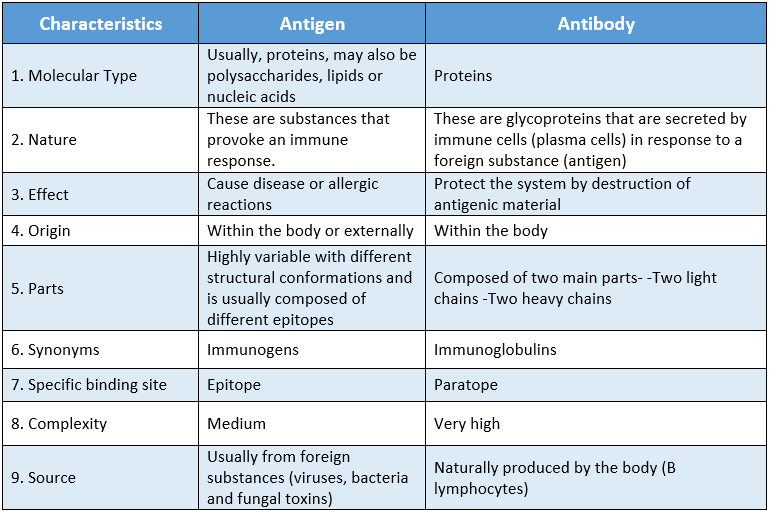Chapter 4 Biology And Human Welfare Immunity And Human Diseases Long Answer Type Questions
Question 1. Briefly describe the different types of immunity.
Answer:
Different types of immunity:
Immunity is of two types:
1 Innate or natural or non-specific Immunity:
Innate immunity refers to non-specific defense mechanisms that come into play immediately or within hours of an antigen’s appearance in the body. It consists of various types of physical, and physiological barriers.
Example: The skin (the physical barrier) prevents entry of microorganisms; mucous membrane, and acid of the stomach (physiological barrier) kill most microorganisms.
2 Acquired immunity or adaptive or specific Immunity:
The immunity that an individual acquires after birth is called acquired immunity. It is specific and mediated by antibodies or lymphocytes or both which make the antigen harmless. It is of two types, active immunity, and passive immunity.
Read and Learn More WBBSE Class 9 Life Science MCQs
1. Active Immunity: In this case, a person’s own cells produce antibodies in response to infection or vaccination. It is slow and takes time for the formation of antibodies. It is long-lasting and harmless.
Active immunity may be natural or artificial:
1. A person who has recovered from an attack of small pox or measles or mumps develops natural active immunity.
2. Artificial active immunity is the resistance induced by vaccines. Examples of vaccines are-BCG vaccine, MMR vaccine, etc.
2. Passive Immunity:
When ready-made antibodies are directly injected in an individual against foreign agents, it is called passive immunity. It provides immediate relief but is not long-lasting.
It may be natural or artificial:
1. Natural passive immunity is the resistance passively transferred from the mother to the fetus through the placenta or through colostrum (a yellowish fluid secreted initial days of lactation).
2. Artificial passive immunity is the resistance passively transferred to a recipient by the administration of antibodies. For example, Anti tetanus serum (ATS) is prepared in horses by active immunization of horses with tetanus toxoid, withdrawal of blood, and separation of the serum. ATS is used for passive immunization against tetanus.
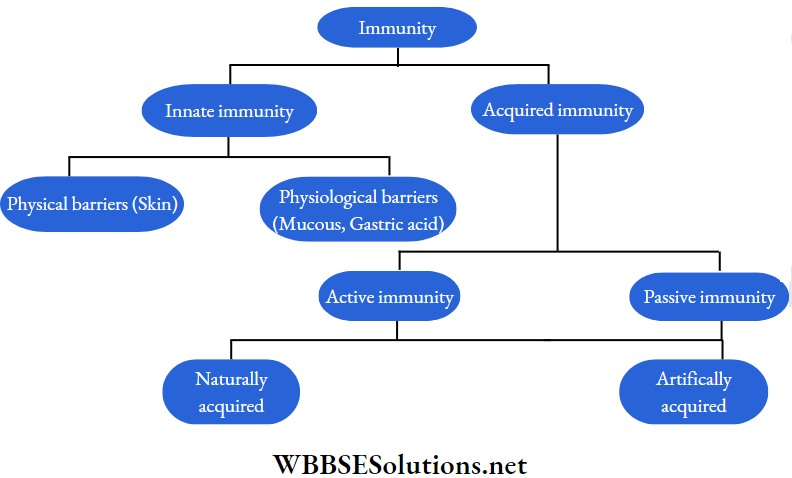
WBBSE Life Science And Environment Class 9 Solutions
Question 2 Write the characteristics or features of the antigen. How do you recognize antigens? Or, State the properties of the antigen.
Answer:
Characteristics/features of antigen:
The features or characteristics of antigen are as follows:
Foreignness:
The immune system normally discriminates between self and non-self such that only foreign molecules are immunogenic. When an antigen is introduced into an organism, the degree of its immunogenicity depends on the degree of its foreignness.
2 Molecular size:
In general, the larger the molecule the more immunogenic it is likely to be. The best immunogens tend to have a molecular mass approaching 100,000 Da. The immunogens with lower efficiency generally have a molecular size between 5000-10000 Da.
3 Chemical composition:
They are structural proteins in nature. Sometimes it may be composed of polysaccharides, lipids, and nucleic acid.
4 Antigen binding site:
It has a specific region that interacts with antibody (Ab) which is known as an epitope.
Properties of antigen:
Antigens can be recognized by some of their properties.
The properties of antigens are:
1 Antigenicity: The ability to cause the production of antibodies.
2 Antigenic specificity: The ability to enter into an interaction with the corresponding antibodies.
3 Allergenicity: Having the capacity to induce allergy (hypersensitivity).
4 Immunogenicity: Property inducing a detectable immune response.
Question 3. Mention the characteristic features of antibodies. Briefly describe the structure of the most common antibody present in human plasma.
Answer:
Characteristics features of antibodies:
Characteristic features of antibodies are as follows:
1. Antibodies are glycoproteins commonly called immunoglobulins.
2. The molecular weight of an antibody ranges from 150000 to 950000 Da.
3. Antibodies are antigen-specific.
Structure of antibody:
Immunoglobulin G or IgG is the most common antibody present in human plasma.
The structure of IgG is mentioned below:
1. The Immunoglobulin G molecule is a ‘Y-shaped structure.
2. Each molecule has a specific antigen-binding site, by which it attaches with a specific antigen to inactivate it.
3. The immunoglobulin molecule is composed of 4 polypeptide chains of which two are heavier and two others are lighter in weight. These chains remain attached to disulfide bonds.
4. The two forked arms are made up of one light and one heavy chain each. The stem arm of the IgG molecule is composed of two heavy chains.
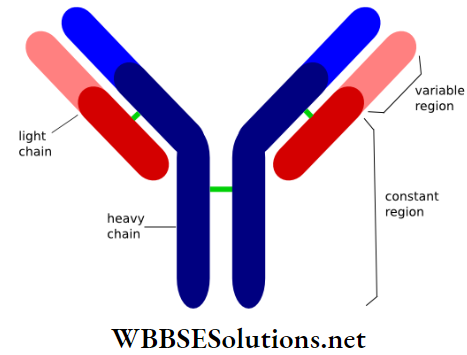
WBBSE Life Science And Environment Class 9 Solutions
Question 4. Write a brief description of different types of immunoglobulins.
Answer:
Description of different types of immunoglobulins:
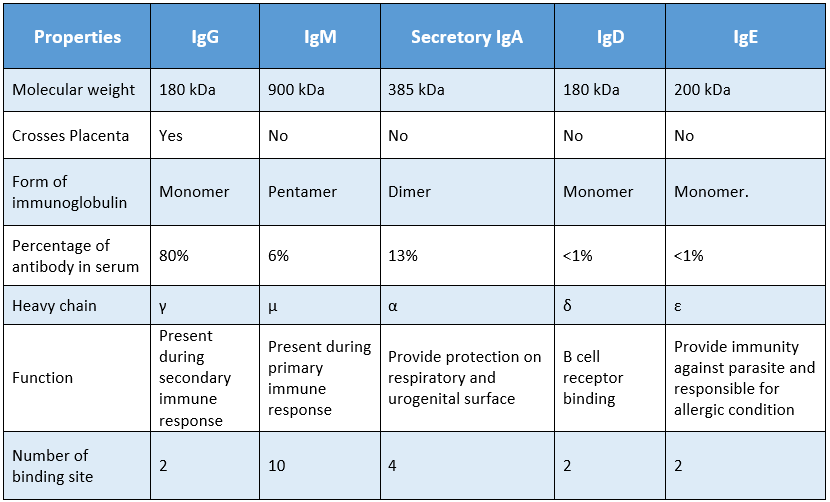
Question 5 Differentiate between antigen and antibody.
Answer:
Difference between antigen and antibody:
WBBSE Life Science And Environment Class 9 Solutions
Question 6 What is humoral immunity? How does humoral immunity work?
Answer:
Humoral immunity:
The immune response, which involves the action of different B lymphocytes, like plasma cells, for producing antigen-specific antibodies and memory cells for neutralizing or eliminating toxins and pathogens in the blood and lymph is called humoral immunity.
Mechanism of humoral immunity:
Humoral immunity works for both primary and secondary immune responses. In primary response, B lymphocytes develop typical antibody-producing plasma cells. These cells produce antigen-specific antibodies. Antibodies work in the following four ways.
1 Agglutination:
By this process, antibodies agglutinate pathogens into clusters, which are then collectively phagocytized by macrophages.
2 Precipitation:
Some antigen molecules are clamped by antibodies and are precipitated.
3 Opsonisation:
Antibodies form a covering on the antigens so that the phagocytic cells can ingest packed antigens.
4 Neutralisation:
Certain toxic antigens are detoxified and inactivated by the antibodies. In secondary response memory, B cells play a major role. These cells are produced during a primary immune response and remain stored in the secondary lymphoid tissues for keeping the immunological behavior of the pathogen in memory of the body’s immune system. In case of another attack, these cells help in the quick activation of the body’s immune system.
Question 7. Write the differences between humoral immunity and cell-mediated immunity.
Answer:
Difference between humoral and cell-mediated immunity:
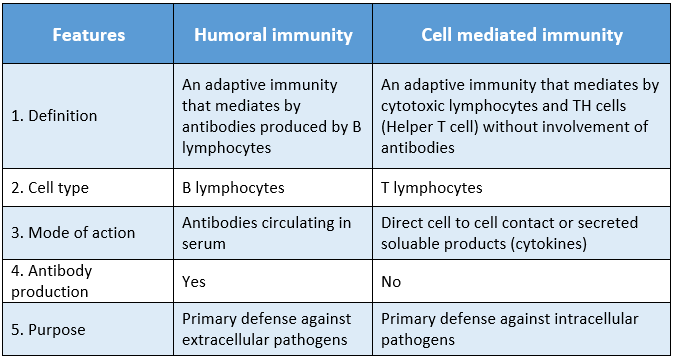
Question 8 Mention the roles of different T cells in the immune response. Mention the roles of different B cells in immune response.
Answer:
Roles of different T cells:
Different T cells or T lymphocytes play different roles in the immune response of the body.
They are as follows:
1. Cytotoxic T cells or T cells kill the infected cell, to destroy antigen-carrying pathogens within it.
2. Helper T cells or T cells enhance the activity of killer cells (a type of T cells), antibody-producing B cells, and phagocytic macrophages.
3. Suppressor T cells or T cells destroy T cells, TH cells, and B cells to stop immune response after the elimination of the antigens.
Roles of different B cells:
Different B cells or B lymphocytes play different roles in the immune response of the body.
They are as follows:
1. Plasma cells originated from B cells produce specific antibodies to inactivate antigens.
2. Memory B cells remain in lymph glands, keeping the nature of antigens in memory, and taking quick action in case of any further attack.
WBBSE Life Science And Environment Class 9 Solutions
Question 9 Briefly describe the mechanism of the immune response against viral attack in the human body.
Answer:
Mechanism of the immune response against a viral attack:
The immune response is a complex process involving various cells and biochemical components inside the body.
The steps of the immune response against the viral antigen are as follows:
1. As any virus reaches the blood or attacks any body cells, large phagocytic macrophages engulf those infected cells. Soon viral antigens appear on the cell surface of macrophages.
2. High concentration of viral antigens on macrophage activates helper T lymphocytes in the blood.
3. Helper T cells immediately initiate the production of cytotoxic killer T cells, memory T cells, and B lymphocytes.
4. B lymphocytes proliferate very fast to produce plasma cells and memory B cells.
5. Plasma cells produce specific antibodies to bind and inactivate the virus before they get a chance to infect a cell.
6. Killer. T cells destroy the infected body cells along with viruses.
7. T and memory B cells stay in the body to recognize the same pathogen in case of further infection and to develop a quicker response.
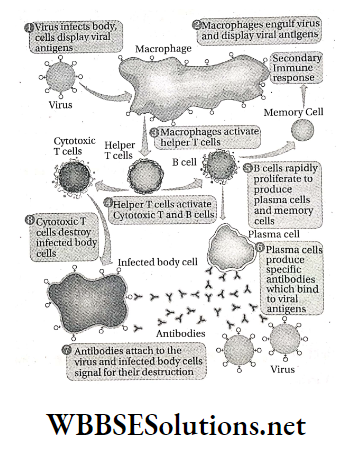
Question 10 Mention the differences between B cells and T cells.
Answer:
Differences between B cells and T cells:
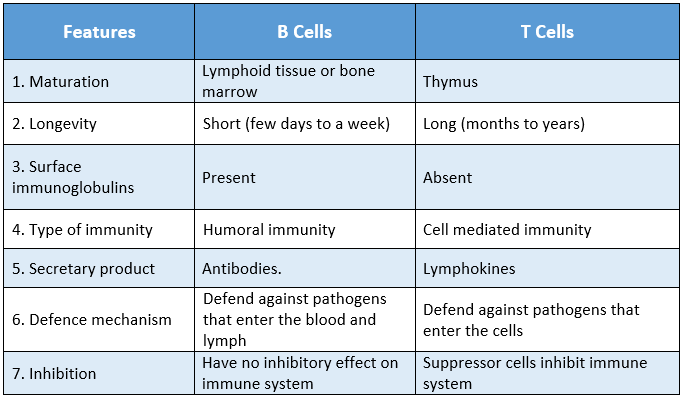
WBBSE Life Science And Environment Class 9 Solutions
Question 11. Write the differences between primary immune response and secondary immune response.
Answer:
Difference between primary immune response and secondary immune response:
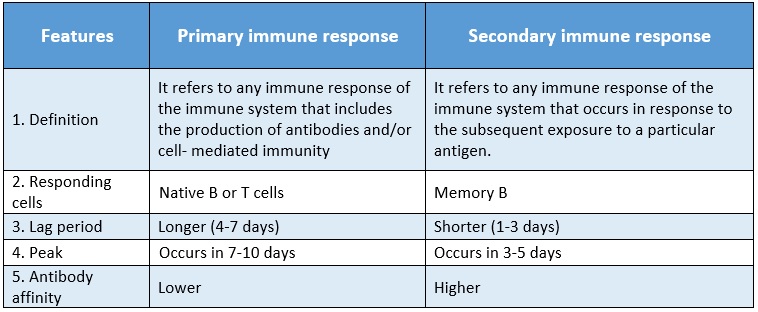
Question 12. Give a brief historical account of the discovery of the smallpox vaccine.
Answer:
Discovery of smallpox vaccine:
The scientific concept of vaccination was developed in the later half the of 18th century when a number of scientists and physicians were working hard to develop a vaccine against smallpox, the most deadly and contagious disease of that time.
Scientists noticed that most individuals, who once suffered from cowpox safely bypassed smallpox. But the search was on for long 25 years. Then Dr. Edward Jenner (1798) broke through the concept of vaccination.
He collected a little pus from a cowpox vesicle on the hand of Sarah Nelmes, a milkmaid, and introduced it into the arm of James Phipps, an eight year old boy. After two months, the boy was inoculated with the smallpox virus, but he did not develop the disease.
The modern concept of vaccination is standing in this story. After this discovery, the practice of vaccination took the correct route. After a long battle for about two centuries, smallpox has now been eradicated from the world.
Question 13. What is a vaccine? Mention the basic working principles of vaccines to develop immunity in the body.
Answer:
Vaccine:
The vaccine is an antigenic material that is prepared with killed or weakened pathogens, part of pathogens, bacterial toxins, or microbial proteins, which do not cause illness but provide active acquired immunity against those pathogens when introduced into the body.
Working principle of vaccines:
By vaccination, a killed germ, attenuated (weakened) germ, toxoids (toxins collected from germs) or subunits (fragments of proteins from germs) are introduced into the body of an individual. These may be injected or administered orally.
As soon as the substance enters the body, antigens present in it, activate the immune system and initiate an immune response. T cells and B cells take a little time to inactivate such little quantity of antigens and this process is known as primary immune response.
However, in this case, the main function is done by memory B cells. These cells, produced during the immune response, are retained in lymph nodes such as the spleen, thymus, etc. for a long time.
In case of any future infection by the same germ, these memory cells recognize those antigens instantly and inactivate or destroy the attacker very fast. This process is recognized as a secondary immune response. Thus, a successful vaccination immunizes a person effectively.
WBBSE Class 9 Life Science Solutions
Question 14. Give a brief account of different types of vaccines.
Answer:
Types of vaccines:
With the development of science, new and advanced varieties of vaccines are being developed. Till date World Health Organization (WHO) has licensed vaccines for 25 diseases.
Different types of vaccines are:
1 Killed vaccine:
These vaccines contain killed pathogens. Vaccines of cholera, plague, and influenza are of this type.
2 Live attenuated vaccine:
By some laboratory techniques virulence of the pathogens are reduced to prepare this type of vaccines. Vaccines of mumps, measles, and rubella (MMR vaccine) are of this type.
3 Toxoid vaccine:
This type of vaccine is prepared by inactivated toxins from pathogens. Vaccines of tetanus and diphtheria are of this type.
4 Conjugate vaccine:
Generally, the polysaccharide of the bacterial capsule is attached to a protein to prepare this vaccine. The body’s immune system can recognize this conjugated protein and keep it in memory for future immune responses. Vaccine against Haemophilus influenza
5 Sub-unit vaccines:
This type of vaccine is prepared by small fragments of pathogenic protein. Vaccine against Hepatitis B is of this type.
6 Heterotypic vaccine:
This is prepared by pathogens, causing disease to other animals but less or non-virulent to humans. Vaccines of smallpox and tuberculosis are of this kind.
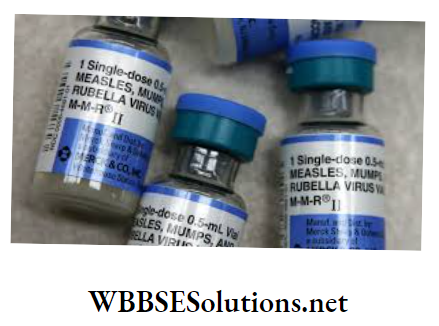
WBBSE Class 9 Life Science Solutions
Question 15. Mention briefly about the nature, symptoms, and mode of transmission of some human diseases.
Answer:
Description of some human diseases:
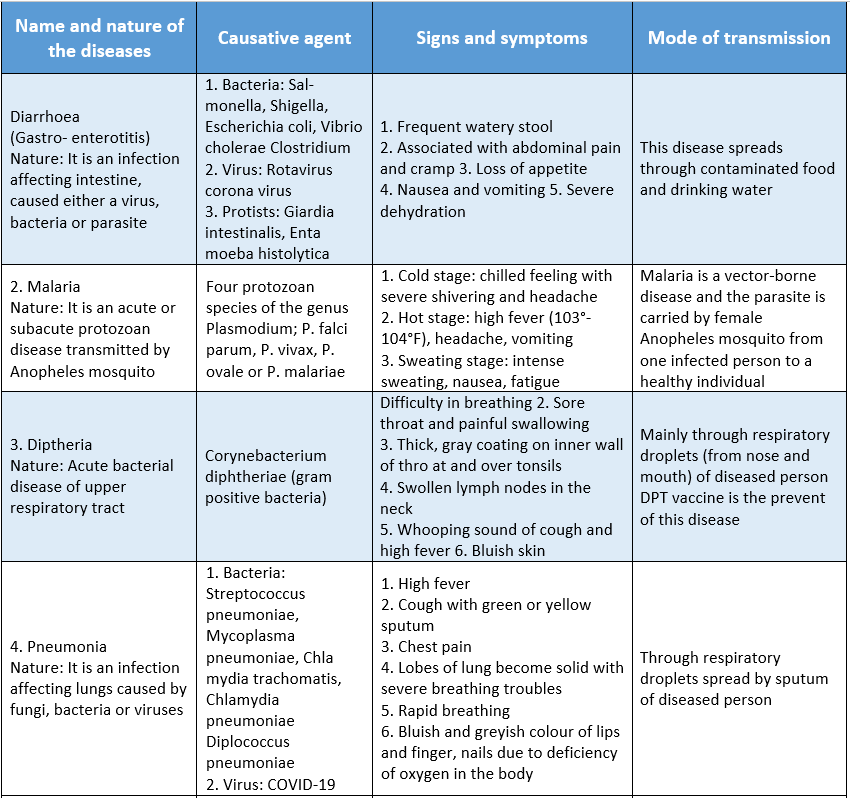
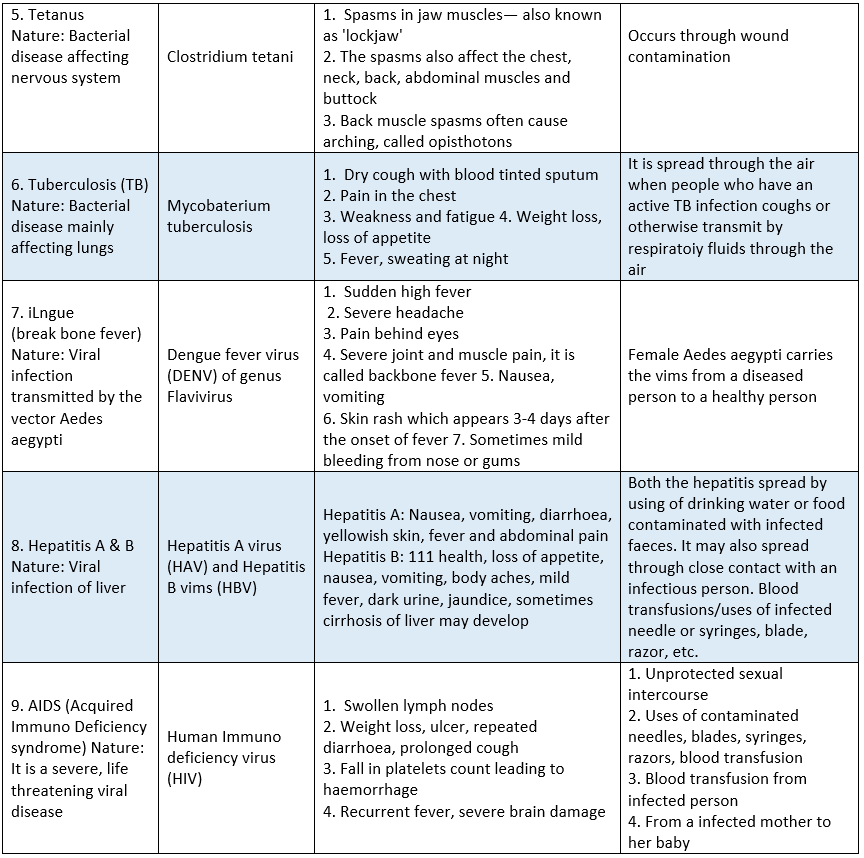
Question 16 Explain the importance of hand washing. Write the components use in washing.
Answer:
Importance of hand washing:
1 Reducing the number of infections:
Hand washing can prevent about 30% of diarrhea-related sicknesses and about 20% of respiratory infections (e.g. common cold, meningitis, flu, hepatitis A) and most types of infectious diseases.
2 Reducing child death:
About 1.8 million children under the age of 5 die every year from pneumonia and diarrhea-related diseases. Washing hands carefully and thoroughly can help children and childcare providers stay healthy.
3 To remove dirt:
Removing dirt through hand washing may even help prevent skin and eye infections.
Components used in washing:
1 Water:
Pure distilled water is the main component used in hand washing.
2 Soap and Detergent:
Water is not efficient for cleaning skin because fats and proteins which are components of organic oil are not readily dissolved in water. Removal of micro-organisms from the skin may be enhanced with the use of soaps and detergents.
3 Hand antiseptic:
Hand sanitizers containing a minimum of 60% to 70% alcohol are and efficient germ killer.
4 Shampoo:
Shampoos that contain selenium are effective in controlling dandruff. Dandruff is caused owing to fungal infection on the scalp.
5 Thimerosal:
An organic compound containing mercury can be used for disinfection of skin and instruments.
6 Wipes:
Hand washing with wipes is also recommended by CDC (Centers for Disease Control and Prevention). This washing is convenient during traveling when water and soap will not be available.
7 Toothpaste and mouthwash:
It is used in brushing teeth and washing mouth.
8 Disinfectant:
Phenyl, bleaching powder is applied in our surroundings to keep the environment clean.
WBBSE Class 9 Life Science Solutions
Question 17. Why and when should an individual wash their hands? Write down the proper method of washing hands.
Answer:
Reason of washing hands:
We take food with hand. We often touch our lips, face, and nose with our hands. By contaminated hands, germs or toxins may enter our body through the mouth, eyes, and nose. Therefore, one must wash the hands to stay healthy.
Time of washing hands:
Hands must be washed before:
1. Taking food
2. Cooking
3. Serving food
4. feeding and attending to a baby or a patient.
Proper washing of hands is a must after using the toilet, cleaning raw vegetables, fish, and meat, attending to a patient, sweeping and cleaning rooms and toilets, polishing shoes and tying shoe-laces, checking the air pressure of the cycle tire, coming home from outside, etc.
The proper method of washing hands:
The proper method of washing hands is mentioned below:
1. Wet your hands with clean water.
2. Take liquid hand-wash or soap in wet hands and rub it for one or two minutes to make rich foam.
3. Carefully rub in between all fingers.
4. Place the hands under running water and continue rubbing until the foam clears.
5. Close tap with a clean cloth and wipe the hand with a dry and clean towel.

Question 18 Write a short note on the ‘WASH’ program of UNICEF. ‘WASH’ program of UNICEF
Answer:
The percentage of healthy children in a population is the index of development of a nation. But it is unfortunate that even in the 21st century, millions of children suffer from diarrhea and several other water-borne diseases.
This happens because of contaminated water, which occurs mostly due to a lack of proper sanitation. 44% of the global population defecates in open areas. Feces contain numerous germs, which easily contaminate water, especially during the rainy season.
In view of that, UNICEF (United Nations International Children’s Emergency Fund) has developed a global strategy to lift the standard of health of school children by providing them with adequate drinking water, infrastructure for proper sanitation, and a sense of hygiene.
This program is popularly known as ‘WASH’ (Water Sanitation Hygiene Programme). United Nations has set a goal for sustainable development of the standard of living of the world population in this millennium.
To reach the target, UNICEF has developed a strategy to maximize child survival rate by providing access to adequate drinking water, and sanitation facilities to schools all over the world along with education and nutrition.
WBBSE Class 9 Life Science Solutions
Question 19 Describe the WASH strategy taken by UNICEF to improve hygiene behavior among school children. How can the WASH program be made successful?
Answer:
WASH strategy to improve hygiene behavior among school children:
Schools are the places where a child spends most of the time of his or her life all through the development period. So UNICEF has developed the plan to make every school a child-friendly place.
In view of that UNICEF has extended both monetary and strategic support to all developing countries of the world to develop infrastructure for child-friendly schools. The strategy to enhance child survival and development, UNICEF has encouraged a three-pillar approach.
The first is enabling a child-friendly environment in the school. Next is to improve hygiene behavior among the students and the third one is to build infrastructure for water supply and sanitation services.
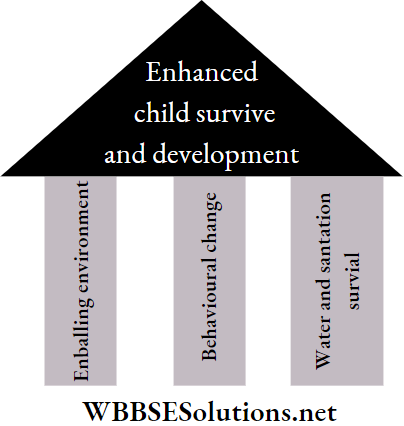
Points to make WASH successful:
The points to make WASH successful are as follows:
1. Wash your hands with adequate water and soap before taking food and after using Three pillar approach of WASH toilets.
2. Always use sanitary toilets.
3. Clean raw fruits and vegetables before consuming.
4. Keep a close vigilance on drinking water sources to reduce contamination to zero.
5. Clean water storage containers every day.
6. Keep your domestic and school toilets clean.
7. Clip your nails regularly and do not let any filth to deposit under it.
Question 20. Mention different hygienic practices to secure the good health of a person as well as of society.
Answer:
Different types of hygienic practices:
The conditions or practices helpful to maintain health and to prevent diseases, especially through cleanliness are known as hygiene. Hygiene can be practiced in three different levels, i.e., personal, household, and social levels, which are mentioned below.
1 Personal level hygiene:
1. Cleaning hands before taking food, after using the toilet, and handling any unclean material.
2. Brushing teeth after taking a meal and before going to bed.
3. Taking a bath once or twice a day.
4. Trimming hair and clipping nails regularly.
2 Household level hygiene:
1. Washing and sun-drying clothing and bedding at regular intervals.
2. Cleaning utensils, kitchen equipment, raw vegetables, fish, and meat.
3. Cleaning toilets, basins, and sinks.
4. Cleaning and disinfecting water reservoirs.
3 Social level hygiene:
1. Cleaning of sewage system at regular intervals.
2. Maintaining general cleanliness in hospitals, educational institutions, marketplaces, railway stations, bus terminus, auditoriums, theaters, and other community places.
3. Regular cleaning and disinfecting of public toilets.

